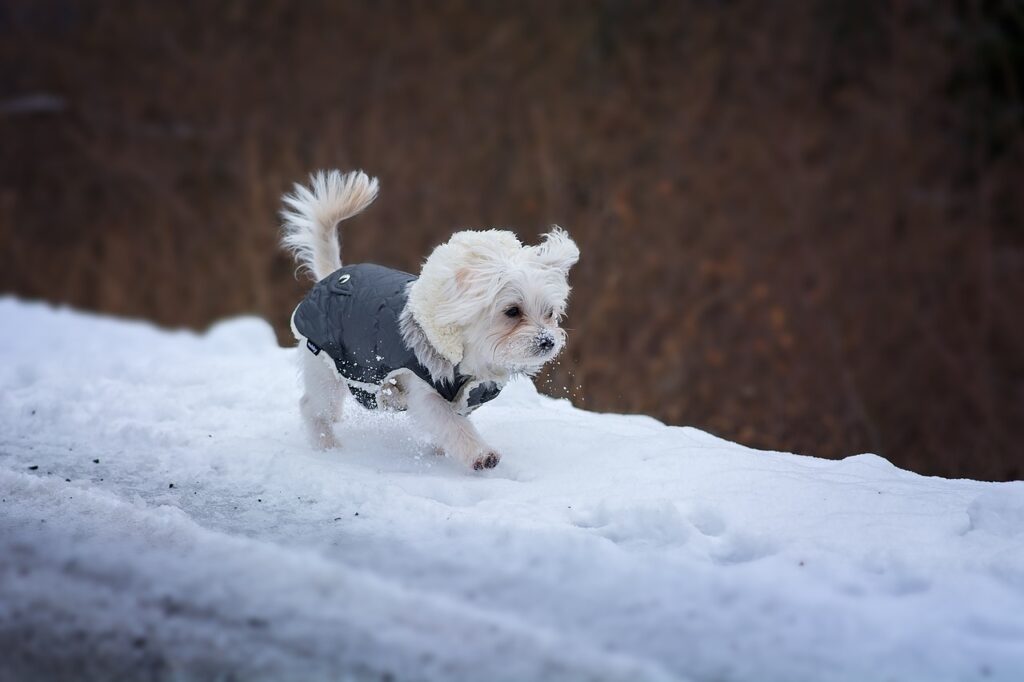Winter can be a troubling season for dogs due to the frigid temperatures, snow, and salt use. Follow these winter care tips for your dog to make the season safer and more enjoyable for you and your canine companion!

Table of Contents
1. Pet-Friendly De-Icing Products
Typical de-icing products are not meant to come in contact with a pet’s paws and can be harmful. These products can cause chemical and physical irritation that is damaging to the skin. The presence of salt on their paws will also cause your pet to lick their paws. This can cause further physical irritation to the skin. Upon licking their paws they may also be at risk of ingesting the de-icing product off of their paws. This may result in gastrointestinal upset such as vomiting and diarrhea.
The solution to this is using pet-friendly salts as they have been developed with the help of veterinarian(s) to ensure the safety of your pet’s paws by reducing the chemical irritation.

2. Dog Booties
Essentially little shoes for your pet! Booties act as a physical barrier between the winter environment and your pet’s paw. They can eliminate chemical irritation from salt use, and protect your pet from the cold. They also prevent snowball formation on and between your pet’s paw pads, allowing for a more enjoyable walk for both you and your pet- and a mess-free clean-up when you arrive home! Find the 5 dog booties we recommend here.

3. Paw Balm
Paw balm is designed to protect your pet’s paws from harsh winter conditions. It shields their paws from chemical and physical irritation while also maintaining moisture. The balm promotes healthy skin by soothing dry and cracked skin. It is easy to use as you rub it onto their paws like a wax-like lotion. It can be used in conjunction or as an alternative to booties. Most balms can also be used on the nose to keep their nose in tiptop shape too!

4. Routine Grooming
Schedule routine grooming appointments to maintain hair growth on paws. Overgrown hair on their paws will contribute to the formation of snowballs around and between paw pads. This can cause discomfort and irritation, as the snowballs are heavy and of course cold! Refrain from shaving their coat though, as that provides insulation from the cold temperatures.
5. Shorten Walks
Shorten the length of your pet’s walk to accommodate for chilling winter conditions. With wind, snow, and ice you may find that your pet doesn’t tolerate long walks as they would in warmer months. Some signs of decreased tolerance would be; limping, slower walking pace, sitting, or refusing to walk any further. If you are able to, your pet would likely enjoy shorter more frequent walks instead.
6. Clean Their Paws
Once you get home after the walk prepare a warm bowl of water to dip your pet’s paws into. Then wipe their paws clean and thoroughly dry them afterward. This will remove any de-icing products and snow that your pet had come in contact with throughout the walk. This will reduce irritation to their paws. It will also prevent gastrointestinal upset as they will not be licking de-icing agents off of their paws. If your pet won’t tolerate dipping their paws into water, a cloth dipped in warm water will do the trick!
7. Dress For The Weather
There is a lot of apparel available for pets these days and although some may look silly- they are quite practical! Whether your dog is big or small, typically they can benefit from wearing a sweater (unless they are a breed with a thick coat). This can help your pet feel more comfortable and cozy on their walk in the cold weather. It will also make clean-up easier for you once you get home as the clothing is a physical barrier against salt, snow, and ice. This will help protect against irritation and snowball formation on their abdomen. If it is cold enough for you to bundle-up to go for a walk, then consider bundling your dog up as well!
8. Make Your Pet More Visible
Make your pet more visible in dark conditions. With the sun setting so much earlier in the winter season it greatly decreases visibility. This can be concerning when you are crossing streets, or if you have your pet off-leash. To increase the visibility of your pet you can use reflective wear such as a coat, or collar lights! These are especially important if you are crossing streets with your pet to ensure their safety from cars. It is also useful to deter predators, such as coyotes, from approaching your pet.


9. Avoid Puddles and Spills
During the winter, antifreeze is commonly used and you may come across it on your walk(s). Refrain from letting your pet ingest any fluid found on the ground as if it could contain antifreeze. This product is toxic to dogs and cats and is can be life-threatening if ingested!
Following these winter care tips for your dog will surely make the winter season more safe and enjoyable you and your companion!
Frequently Asked Questions
You can prepare your dog for snow with jackets, booties, and paw balm. Follow our guide above!
You can do so by using paw balm to protect their paws and keep their skin well hydrated. Moreover, you can use dog booties to protect them from chemical and physical injury of their paws.

